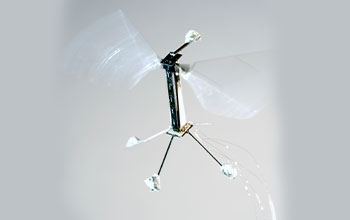Multimedia Gallery
RoboBee is inspired by biology of a fly
Inspired by the biology of a fly, the RoboBee has submillimeter-scale anatomy and two wafer-thin wings that flap almost invisibly at 120 times-per-second.
More about this image
The demonstration of the first controlled flight of an insect-sized robot was the culmination of more than a decade's work, led by researchers at the Harvard School of Engineering and Applied Sciences (SEAS) and the Wyss Institute for Biologically Inspired Engineering at Harvard. This research was supported by the National Science Foundation and Wyss.
The tiny robot flaps its wings with piezoelectric actuators—strips of ceramic that expand and contract when an electric field is applied. Thin hinges of plastic embedded within the carbon fiber body frame serve as joints, and a delicately balanced control system commands the rotational motions in the flapping-wing robot, with each wing controlled independently in real-time.
Potential applications of the RoboBee project could include distributed environmental monitoring, search-and-rescue operations or assistance with crop pollination, but the materials, fabrication techniques and components that emerge along the way might prove to be even more significant.
Read more about this research in the Harvard news story Robotic insects make first controlled flight. (Date image taken: May 2013; date originally posted to NSF Multimedia Gallery: Oct. 19, 2017)
Credit: Photos courtesy of Kevin Ma and Pakpong Chirarattananon, Harvard School of Engineering and Applied Sciences
Images and other media in the National Science Foundation Multimedia Gallery are available for use in print and electronic material by NSF employees, members of the media, university staff, teachers and the general public. All media in the gallery are intended for personal, educational and nonprofit/non-commercial use only.
Images credited to the National Science Foundation, a federal agency, are in the public domain. The images were created by employees of the United States Government as part of their official duties or prepared by contractors as "works for hire" for NSF. You may freely use NSF-credited images and, at your discretion, credit NSF with a "Courtesy: National Science Foundation" notation.
Additional information about general usage can be found in Conditions.
Also Available:
Download the high-resolution JPG version of the image. (2.0 MB)
Use your mouse to right-click (Mac users may need to Ctrl-click) the link above and choose the option that will save the file or target to your computer.



 All images in this series
All images in this series